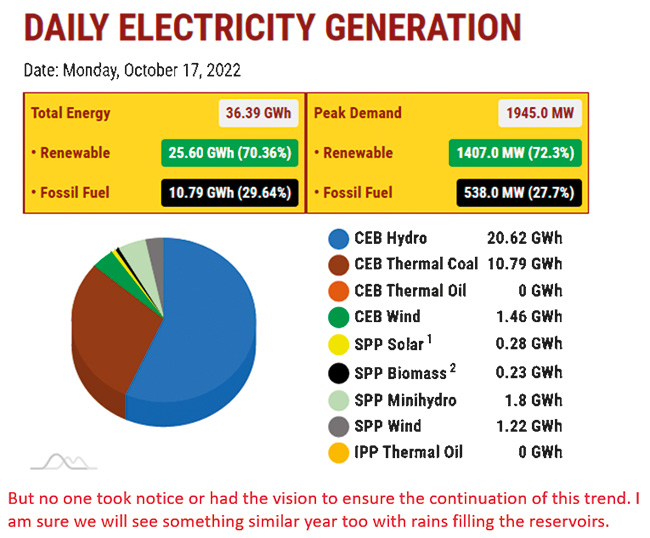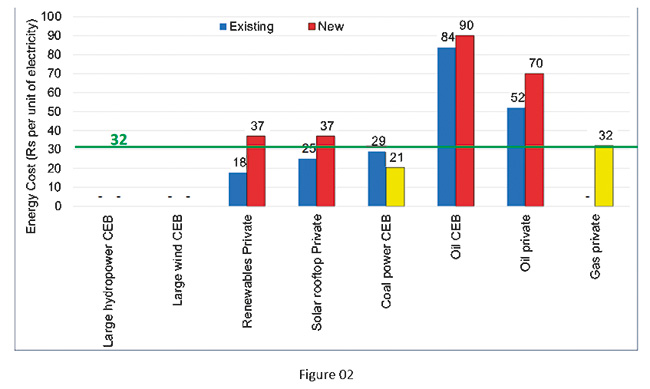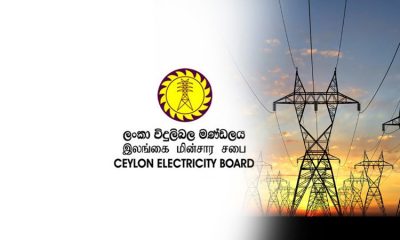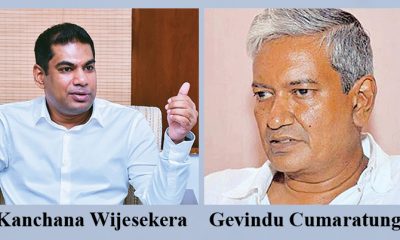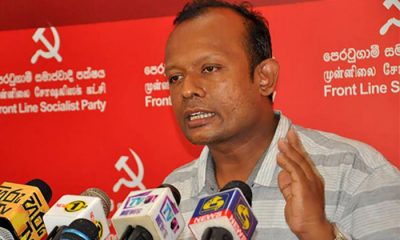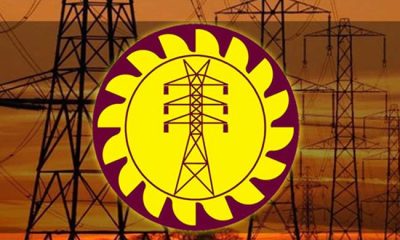Features
Another electricity tariff hike: Is there no option for Sri Lanka?

by Eng Parakrama Jayasinghe
parajayasinghe@gmail.com
Electricity consumers reeling from the massive increase in tariff in February (adjusted somewhat in July 2023) were naturally appalled by the request for a further increase by the Ceylon Electricity Board (CEB). A public consultation was held on 18 October 2023 by the Public Utilities Commission of Sri Lanka (PUCSL) to seek the stakeholders’ views on the CEB’s request for a tariff increase. However, the many representations made both in writing and orally at the public hearing do not seem to have had any impact; the PUCSL has allowed the tariff increase of 18% sought by the CEB. It is however somewhat relieving that permission has been granted conditionally. More on that later.
The rationale for the electricity tariff increases is that the CEB needs to cover costs. While the principle of cost reflective tariff is acceptable it must be read in conjunction with the provision in the PUCSL Act which states, among other things:
PUCSL Powers and Obligations
Excerpts of the Electricity Act No 20 of 2009:
· Clause 3 (1) d – ‘to regulate tariffs and other charges levied by licensees and other electricity undertakings, in order to ensure that the most economical and efficient services possible is provided to consumers.
· Clause 4 (1) a – ‘to protect the interests of consumers in relation to the supply of electricity by promoting efficiency, economy and safety by persons engaged in or in commercial activities connected with the generation, transmission, distribution, supply and use of electricity.
· Clause (1) c – ‘to secure that licensees acting efficiently will be able to finance the carrying on of the activities authorized or required by their licences.
(These clauses have not been revised in the amendments to the Act in 2013 or 2023)
During the aforesaid consultation, many startling revelations emerged. Firstly, the CEB itself admitted that the expected loss incurred was not 30 billion as originally claimed but Rs 18.5 billion. Also, the PUCSL has also contested the daily demand values and the estimation of the hydro resource availability expectations in the coming months. Many industry experts too contested those estimates.
A request for tariff increases without due diligence to ensure the above criterion is not logical by any means.
Past practices
However, we Sri Lankans are left with Hobson’s choice when the CEB requests a tariff hike after running up massive losses. It can do as it pleases after incurring losses and expects the Treasury to bridge its deficits. Unfortunately for us citizens, the Treasury has been doing just that and the net effect is that consumers indirectly bear such burden without any recourse for redress.
Records indicate that in the past decade alone the CEB has thus caused losses amounting to Rs 1 trillion and still remains afloat thanks to funds provided by the Treasury or state banks.
It is of some comfort that the Treasury has apparently decided to discontinue this practice.
Present situation
When the February tariff hike was imposed, it was claimed that with that the CEB would be at least cost neutral and would not need further subsidies. Either it was false promise or the CEB had no intention of honouring it.
Now, the CEB has obtained a further tariff hike to cover losses already made. What would happen if it couldn’t secure a tariff increase? Could the Treasury make funds available, as it did in the past? If it does, there would be further increase in taxes and tariffs. Head we lose tails they win!
Reasons for the CEB’s failure to be become cost neutral as promised are as follows:
• Indiscriminate use of oil-based power generation
• Completely ignoring the principle of adopting least cost mode of generation
• Inability of meet the fund requirement to purchase coal
• Irrational and politically motivated steps to provide power 24/7 irrespective of cost and no one being accountable for such costs
• Ignoring the fact that Sri Lanka is still bankrupt
• No effort to facilitate and accelerate the development of much more economical Renewable Energy
The need for the previous hike was the large increase in cost of both oil/coal-based generation. That should have been recognised by both the CEB and the Ministry and appropriate action taken.
But what did they do? They did away with the 2.5 hr power cut to which the consumers had got accustomed; it would have helped reduce the use of expensive generation options. The government made a political decision, knowing very well that the additional generation had to be oil/coal based at much higher costs.
• The CEB was not keen to reach cost effectiveness or seek more logical and economical modes of power generation.
• All past losses were taken up by the Treasury – eventually passed on to the consumers indirectly. One trillion rupees has thus been ‘stolen’ from the people over the past decade.
• No one is held accountable for such irresponsible behaviour.
• No plans in place to reach the much talked about 70% RE by 2030
• Is 70% renewable energy an achievable goal? The feasibility was demonstrated some days last year. But no lessons were learned. (See Figure 01)
Power cuts cannot be avoided just yet
The unpalatable truth is that we do not have enough foreign exchange for oil and coal imports. Electricity generated using coal and oil costs Rs 70.00 a unit and Rs 120.00 unit, respectively, and losses will be Rs 41.00 a unit and Rs 91.00 a unit respectively, whereas all renewable energy-based generation costs are significantly lower.
As such, even though the use of coal with whatever funds allocated cannot be avoided in the dry months of the year, to limit the number of hours of power cuts, no such justification can be made for continued use of oil for power generation. Electricity consumers will come to terms with reality and the difficulties that limited power cuts cause, if they are convinced that the authorities concerned will do their utmost to solve the problem expeditiously.
There has been no attempt to accelerate the addition of low-cost renewable energy power generation, which is the most economical and does not require any foreign exchange, even though the authorities are fully aware of the drought months at the beginning of the year. The rooftop solar power generation is the most feasible option at no cost to the state and could help meet the shortfall in the hydro power generation during the dry months.
The comparison of costs of generation
The chart presented by Dr Tilak Siyambalapitiya at the Public Consultation is reproduced with his permission. It reveals the reality of the present debacle. (See Figure 02)
It is obvious that the average variable cost of Rs 32 per kWh has resulted from the high dependence on the use of oil. As such, the only way to bring it down is to stop the use of oil entirely, the possibility of which has become evident on some days. If this requires the re-imposition of some limited power cuts, so be it. If the state takes some meaningful steps to develop the renewable energy sector, particularly by seeking resources from many Green Funds, the present feed in tariff of Rs 37 could come down further. What is equally important is that such tariff provided now is fixed for the next 20 years. Thus, the net present value will be less than Rs 10.00.
The situation during the dry months from January to May will be much worse with an increase in the thermal power generation and the emergency power purchase will send the costs further up. It is already too late for rooftop solar power generation to be stepped up to avert such a situation in 2024. But everything possible must be done to do so for the benefit of everyone.
We had already reached the 70% renewable energy target with Zero Oil
This is the happy scenario that should have been accepted as the way forward with plans being formulated , to ensure that alternative sources of energy were available during the dry months at no cost to the State or the CEB.
While the CEB and the Ministry of Power and Energy lack the perspicacity and the vision or competence to understand this reality, they reject the proposals made by those who have the vision and the ability to expedite the change. The consumers must not be burdened with the unnecessary expenditure on thermal power generation. The standard ruse of awarding contracts for use of emergency power is being repeated this year as well and cannot be allowed.
Overdue payments have discouraged the operators of renewable energy projects beyond measure; many of them have not been paid for 14 months or so although upfront payments are made in dollars for coal and oil imports. The CEB’s colossal losses have come as no surprise.
What about the present demand for price increase?
To ensure compliance and efficiency within the CEB, the PUCSL has set forth a series of conditions for tariff approval. These include the following:
1. To conduct a comprehensive independent audit for the fourth quarter 2023 and report to the Commission – deadline by 31 January 2024
2. To establish a fully functional Bulk Supply Transaction Account (BSTA) – deadline by 31 December 2024
3. To settle all outstanding dues in 2023 to Renewable Energy Generation Licensees – deadline by 31 March 2024
4. To recognise the delay interest due under Standardised Power Purchase Agreements in the financial statements – deadline by 31 March 2024
5. To negotiate and enter into Fuel Supply Agreements with fuel suppliers – deadline by 31 December 2024
6. To liberalise solar rooftop schemes by allowing unhindered transfer to and from different schemes -deadline by 31 March 2024
7. To remove location restrictions for Renewable energy and allow aggregation of consumer accounts (under the same prosumer) for Net Metering and Net Accounting contracts – deadline by 31 March 2024
8. To negotiate, restructure and reduce finance cost (interest rates) – deadline by 31 December 2024
9.To complete and commission the Kothmale – New Polpitiya 220kV Transmission Line – deadline by 31 August 2024
10. To submit a plan to reduce Transmission and Distribution losses over the next five years – deadline by 31 March 2024
11. To submit a plan to encourage energy conservation and efficiency (deadline by 31 March 2024)
12. To reduce employee costs –
· No bonus or other incentive payments for employees for the year
· To ensure succession planning in the years ahead to eliminate/ reduce employee turnover
· Optimal utilisation of existing human resources and minimise new recruitments
13.To eliminate the waste and non-productive expenditure to minimise/eliminate such expenditure in the electricity supply cost
But the question remains whether the CEB will abide by these conditions. What it has done in the past does not inspire much confidence as for its compliance.
Welcome as these conditions are, they are not likely to help sort out the mess in the power and energy sector. The author proposes the following:
· The CEB should not be allowed to seek further tariff increases, based on increased use of fossil fuel or their cost escalations.
· Reimpose the 2.5 hr power cut until achieving the desired average cost of generation
· Cancel all emergency power (Supplementary power) contract for oil-based power generation forth with and do not approve any more contracts in the future
· Plan for continued lowering of average cost of generation over the ensuing years, and impose penalties on the CEB for none achievement
· Settle all outstanding payments to RE developers within six months and avoid any increase in the debt.
· No payments in foreign currency for any RE developers local or foreign. Foreign developers must bring in all the capital required for their development and not be allowed to tap the Sri Lankan banking system to obtain debt funding. Their investments to be recovered and repatriated using the already existing mechanisms of the BOI
· Set in place a program to reach the development of 1,000,000 roof top Solar by 2025 as already targeted and the CEB to be mandated to remove any road blocks with the collaboration with the large number of EPC contractors already registered with the SLSEA under the programs in Surya Bala Sangramaya.
· Declare a time targeted program to retire all existing oil-based power plants before 2030 so that the 70% RE target or better could be achieved while meeting the above generation cost targets.
Way out
Although it is claimed that there will be no more electricity tariff increases until June 2024, nobody takes such pledges seriously. There could be another tariff revision by January with the war in the Middle East pushing the price of oil to $100 or even more.
So, it is time for the consumers to adopt measures to insulate themselves from such further shocks , even if the CEB and the Ministry of Power and Energy continue on the present disastrous path. Fortunately, such options do exist now. From a national perspective it is time to appreciate the need for a paradigm shift in the way the energy sector is viewed. (See Fig 3 )
Consumers can abide by this change and their collective efforts will generate many benefits to the country and pressure the CEB to mend its ways.
Even on the basis of current tariff and interest levels, it is very attractive for the medium to high end domestic consumers to install solar rooftop PV (photovoltaic) systems. They must be encouraged to generate surplus energy so that the export proceeds would be adequate to cover the loan instalments under the Net Accounting system. Although the CEB will lose some revenue from these high-end consumers, it will be able to more than offset such losses by reducing expenditure on coal and oil imports and buy solar power at Rs 37.00 a unit.
This potential has been proved by a study on a sample of 1,500 consumers with monthly consumption exceeding 200 units per month. (See Table)
The CEB must be made to realise that the tariff increase is only a temporary measure and it will not be able to secure further price increases to cover increased costs due to use of fossil fuels and inefficiencies in management.
Features
The heart-friendly health minister

by Dr Gotabhya Ranasinghe
Senior Consultant Cardiologist
National Hospital Sri Lanka
When we sought a meeting with Hon Dr. Ramesh Pathirana, Minister of Health, he graciously cleared his busy schedule to accommodate us. Renowned for his attentive listening and deep understanding, Minister Pathirana is dedicated to advancing the health sector. His openness and transparency exemplify the qualities of an exemplary politician and minister.
Dr. Palitha Mahipala, the current Health Secretary, demonstrates both commendable enthusiasm and unwavering support. This combination of attributes makes him a highly compatible colleague for the esteemed Minister of Health.
Our discussion centered on a project that has been in the works for the past 30 years, one that no other minister had managed to advance.
Minister Pathirana, however, recognized the project’s significance and its potential to revolutionize care for heart patients.
The project involves the construction of a state-of-the-art facility at the premises of the National Hospital Colombo. The project’s location within the premises of the National Hospital underscores its importance and relevance to the healthcare infrastructure of the nation.
This facility will include a cardiology building and a tertiary care center, equipped with the latest technology to handle and treat all types of heart-related conditions and surgeries.
Securing funding was a major milestone for this initiative. Minister Pathirana successfully obtained approval for a $40 billion loan from the Asian Development Bank. With the funding in place, the foundation stone is scheduled to be laid in September this year, and construction will begin in January 2025.
This project guarantees a consistent and uninterrupted supply of stents and related medications for heart patients. As a result, patients will have timely access to essential medical supplies during their treatment and recovery. By securing these critical resources, the project aims to enhance patient outcomes, minimize treatment delays, and maintain the highest standards of cardiac care.
Upon its fruition, this monumental building will serve as a beacon of hope and healing, symbolizing the unwavering dedication to improving patient outcomes and fostering a healthier society.We anticipate a future marked by significant progress and positive outcomes in Sri Lanka’s cardiovascular treatment landscape within the foreseeable timeframe.
Features
A LOVING TRIBUTE TO JESUIT FR. ALOYSIUS PIERIS ON HIS 90th BIRTHDAY

by Fr. Emmanuel Fernando, OMI
Jesuit Fr. Aloysius Pieris (affectionately called Fr. Aloy) celebrated his 90th birthday on April 9, 2024 and I, as the editor of our Oblate Journal, THE MISSIONARY OBLATE had gone to press by that time. Immediately I decided to publish an article, appreciating the untiring selfless services he continues to offer for inter-Faith dialogue, the renewal of the Catholic Church, his concern for the poor and the suffering Sri Lankan masses and to me, the present writer.
It was in 1988, when I was appointed Director of the Oblate Scholastics at Ampitiya by the then Oblate Provincial Fr. Anselm Silva, that I came to know Fr. Aloy more closely. Knowing well his expertise in matters spiritual, theological, Indological and pastoral, and with the collaborative spirit of my companion-formators, our Oblate Scholastics were sent to Tulana, the Research and Encounter Centre, Kelaniya, of which he is the Founder-Director, for ‘exposure-programmes’ on matters spiritual, biblical, theological and pastoral. Some of these dimensions according to my view and that of my companion-formators, were not available at the National Seminary, Ampitiya.
Ever since that time, our Oblate formators/ accompaniers at the Oblate Scholasticate, Ampitiya , have continued to send our Oblate Scholastics to Tulana Centre for deepening their insights and convictions regarding matters needed to serve the people in today’s context. Fr. Aloy also had tried very enthusiastically with the Oblate team headed by Frs. Oswald Firth and Clement Waidyasekara to begin a Theologate, directed by the Religious Congregations in Sri Lanka, for the contextual formation/ accompaniment of their members. It should very well be a desired goal of the Leaders / Provincials of the Religious Congregations.
Besides being a formator/accompanier at the Oblate Scholasticate, I was entrusted also with the task of editing and publishing our Oblate journal, ‘The Missionary Oblate’. To maintain the quality of the journal I continue to depend on Fr. Aloy for his thought-provoking and stimulating articles on Biblical Spirituality, Biblical Theology and Ecclesiology. I am very grateful to him for his generous assistance. Of late, his writings on renewal of the Church, initiated by Pope St. John XX111 and continued by Pope Francis through the Synodal path, published in our Oblate journal, enable our readers to focus their attention also on the needed renewal in the Catholic Church in Sri Lanka. Fr. Aloy appreciated very much the Synodal path adopted by the Jesuit Pope Francis for the renewal of the Church, rooted very much on prayerful discernment. In my Religious and presbyteral life, Fr.Aloy continues to be my spiritual animator / guide and ongoing formator / acccompanier.
Fr. Aloysius Pieris, BA Hons (Lond), LPh (SHC, India), STL (PFT, Naples), PhD (SLU/VC), ThD (Tilburg), D.Ltt (KU), has been one of the eminent Asian theologians well recognized internationally and one who has lectured and held visiting chairs in many universities both in the West and in the East. Many members of Religious Congregations from Asian countries have benefited from his lectures and guidance in the East Asian Pastoral Institute (EAPI) in Manila, Philippines. He had been a Theologian consulted by the Federation of Asian Bishops’ Conferences for many years. During his professorship at the Gregorian University in Rome, he was called to be a member of a special group of advisers on other religions consulted by Pope Paul VI.
Fr. Aloy is the author of more than 30 books and well over 500 Research Papers. Some of his books and articles have been translated and published in several countries. Among those books, one can find the following: 1) The Genesis of an Asian Theology of Liberation (An Autobiographical Excursus on the Art of Theologising in Asia, 2) An Asian Theology of Liberation, 3) Providential Timeliness of Vatican 11 (a long-overdue halt to a scandalous millennium, 4) Give Vatican 11 a chance, 5) Leadership in the Church, 6) Relishing our faith in working for justice (Themes for study and discussion), 7) A Message meant mainly, not exclusively for Jesuits (Background information necessary for helping Francis renew the Church), 8) Lent in Lanka (Reflections and Resolutions, 9) Love meets wisdom (A Christian Experience of Buddhism, 10) Fire and Water 11) God’s Reign for God’s poor, 12) Our Unhiddden Agenda (How we Jesuits work, pray and form our men). He is also the Editor of two journals, Vagdevi, Journal of Religious Reflection and Dialogue, New Series.
Fr. Aloy has a BA in Pali and Sanskrit from the University of London and a Ph.D in Buddhist Philosophy from the University of Sri Lankan, Vidyodaya Campus. On Nov. 23, 2019, he was awarded the prestigious honorary Doctorate of Literature (D.Litt) by the Chancellor of the University of Kelaniya, the Most Venerable Welamitiyawe Dharmakirthi Sri Kusala Dhamma Thera.
Fr. Aloy continues to be a promoter of Gospel values and virtues. Justice as a constitutive dimension of love and social concern for the downtrodden masses are very much noted in his life and work. He had very much appreciated the commitment of the late Fr. Joseph (Joe) Fernando, the National Director of the Social and Economic Centre (SEDEC) for the poor.
In Sri Lanka, a few religious Congregations – the Good Shepherd Sisters, the Christian Brothers, the Marist Brothers and the Oblates – have invited him to animate their members especially during their Provincial Congresses, Chapters and International Conferences. The mainline Christian Churches also have sought his advice and followed his seminars. I, for one, regret very much, that the Sri Lankan authorities of the Catholic Church –today’s Hierarchy—- have not sought Fr.
Aloy’s expertise for the renewal of the Catholic Church in Sri Lanka and thus have not benefited from the immense store of wisdom and insight that he can offer to our local Church while the Sri Lankan bishops who governed the Catholic church in the immediate aftermath of the Second Vatican Council (Edmund Fernando OMI, Anthony de Saram, Leo Nanayakkara OSB, Frank Marcus Fernando, Paul Perera,) visited him and consulted him on many matters. Among the Tamil Bishops, Bishop Rayappu Joseph was keeping close contact with him and Bishop J. Deogupillai hosted him and his team visiting him after the horrible Black July massacre of Tamils.
Features
A fairy tale, success or debacle

Sri Lanka-Singapore Free Trade Agreement
By Gomi Senadhira
senadhiragomi@gmail.com
“You might tell fairy tales, but the progress of a country cannot be achieved through such narratives. A country cannot be developed by making false promises. The country moved backward because of the electoral promises made by political parties throughout time. We have witnessed that the ultimate result of this is the country becoming bankrupt. Unfortunately, many segments of the population have not come to realize this yet.” – President Ranil Wickremesinghe, 2024 Budget speech
Any Sri Lankan would agree with the above words of President Wickremesinghe on the false promises our politicians and officials make and the fairy tales they narrate which bankrupted this country. So, to understand this, let’s look at one such fairy tale with lots of false promises; Ranil Wickremesinghe’s greatest achievement in the area of international trade and investment promotion during the Yahapalana period, Sri Lanka-Singapore Free Trade Agreement (SLSFTA).
It is appropriate and timely to do it now as Finance Minister Wickremesinghe has just presented to parliament a bill on the National Policy on Economic Transformation which includes the establishment of an Office for International Trade and the Sri Lanka Institute of Economics and International Trade.
Was SLSFTA a “Cleverly negotiated Free Trade Agreement” as stated by the (former) Minister of Development Strategies and International Trade Malik Samarawickrama during the Parliamentary Debate on the SLSFTA in July 2018, or a colossal blunder covered up with lies, false promises, and fairy tales? After SLSFTA was signed there were a number of fairy tales published on this agreement by the Ministry of Development Strategies and International, Institute of Policy Studies, and others.
However, for this article, I would like to limit my comments to the speech by Minister Samarawickrama during the Parliamentary Debate, and the two most important areas in the agreement which were covered up with lies, fairy tales, and false promises, namely: revenue loss for Sri Lanka and Investment from Singapore. On the other important area, “Waste products dumping” I do not want to comment here as I have written extensively on the issue.
1. The revenue loss
During the Parliamentary Debate in July 2018, Minister Samarawickrama stated “…. let me reiterate that this FTA with Singapore has been very cleverly negotiated by us…. The liberalisation programme under this FTA has been carefully designed to have the least impact on domestic industry and revenue collection. We have included all revenue sensitive items in the negative list of items which will not be subject to removal of tariff. Therefore, 97.8% revenue from Customs duty is protected. Our tariff liberalisation will take place over a period of 12-15 years! In fact, the revenue earned through tariffs on goods imported from Singapore last year was Rs. 35 billion.
The revenue loss for over the next 15 years due to the FTA is only Rs. 733 million– which when annualised, on average, is just Rs. 51 million. That is just 0.14% per year! So anyone who claims the Singapore FTA causes revenue loss to the Government cannot do basic arithmetic! Mr. Speaker, in conclusion, I call on my fellow members of this House – don’t mislead the public with baseless criticism that is not grounded in facts. Don’t look at petty politics and use these issues for your own political survival.”
I was surprised to read the minister’s speech because an article published in January 2018 in “The Straits Times“, based on information released by the Singaporean Negotiators stated, “…. With the FTA, tariff savings for Singapore exports are estimated to hit $10 million annually“.
As the annual tariff savings (that is the revenue loss for Sri Lanka) calculated by the Singaporean Negotiators, Singaporean $ 10 million (Sri Lankan rupees 1,200 million in 2018) was way above the rupees’ 733 million revenue loss for 15 years estimated by the Sri Lankan negotiators, it was clear to any observer that one of the parties to the agreement had not done the basic arithmetic!
Six years later, according to a report published by “The Morning” newspaper, speaking at the Committee on Public Finance (COPF) on 7th May 2024, Mr Samarawickrama’s chief trade negotiator K.J. Weerasinghehad had admitted “…. that forecasted revenue loss for the Government of Sri Lanka through the Singapore FTA is Rs. 450 million in 2023 and Rs. 1.3 billion in 2024.”
If these numbers are correct, as tariff liberalisation under the SLSFTA has just started, we will pass Rs 2 billion very soon. Then, the question is how Sri Lanka’s trade negotiators made such a colossal blunder. Didn’t they do their basic arithmetic? If they didn’t know how to do basic arithmetic they should have at least done their basic readings. For example, the headline of the article published in The Straits Times in January 2018 was “Singapore, Sri Lanka sign FTA, annual savings of $10m expected”.
Anyway, as Sri Lanka’s chief negotiator reiterated at the COPF meeting that “…. since 99% of the tariffs in Singapore have zero rates of duty, Sri Lanka has agreed on 80% tariff liberalisation over a period of 15 years while expecting Singapore investments to address the imbalance in trade,” let’s turn towards investment.
Investment from Singapore
In July 2018, speaking during the Parliamentary Debate on the FTA this is what Minister Malik Samarawickrama stated on investment from Singapore, “Already, thanks to this FTA, in just the past two-and-a-half months since the agreement came into effect we have received a proposal from Singapore for investment amounting to $ 14.8 billion in an oil refinery for export of petroleum products. In addition, we have proposals for a steel manufacturing plant for exports ($ 1 billion investment), flour milling plant ($ 50 million), sugar refinery ($ 200 million). This adds up to more than $ 16.05 billion in the pipeline on these projects alone.
And all of these projects will create thousands of more jobs for our people. In principle approval has already been granted by the BOI and the investors are awaiting the release of land the environmental approvals to commence the project.
I request the Opposition and those with vested interests to change their narrow-minded thinking and join us to develop our country. We must always look at what is best for the whole community, not just the few who may oppose. We owe it to our people to courageously take decisions that will change their lives for the better.”
According to the media report I quoted earlier, speaking at the Committee on Public Finance (COPF) Chief Negotiator Weerasinghe has admitted that Sri Lanka was not happy with overall Singapore investments that have come in the past few years in return for the trade liberalisation under the Singapore-Sri Lanka Free Trade Agreement. He has added that between 2021 and 2023 the total investment from Singapore had been around $162 million!
What happened to those projects worth $16 billion negotiated, thanks to the SLSFTA, in just the two-and-a-half months after the agreement came into effect and approved by the BOI? I do not know about the steel manufacturing plant for exports ($ 1 billion investment), flour milling plant ($ 50 million) and sugar refinery ($ 200 million).
However, story of the multibillion-dollar investment in the Petroleum Refinery unfolded in a manner that would qualify it as the best fairy tale with false promises presented by our politicians and the officials, prior to 2019 elections.
Though many Sri Lankans got to know, through the media which repeatedly highlighted a plethora of issues surrounding the project and the questionable credentials of the Singaporean investor, the construction work on the Mirrijiwela Oil Refinery along with the cement factory began on the24th of March 2019 with a bang and Minister Ranil Wickremesinghe and his ministers along with the foreign and local dignitaries laid the foundation stones.
That was few months before the 2019 Presidential elections. Inaugurating the construction work Prime Minister Ranil Wickremesinghe said the projects will create thousands of job opportunities in the area and surrounding districts.
The oil refinery, which was to be built over 200 acres of land, with the capacity to refine 200,000 barrels of crude oil per day, was to generate US$7 billion of exports and create 1,500 direct and 3,000 indirect jobs. The construction of the refinery was to be completed in 44 months. Four years later, in August 2023 the Cabinet of Ministers approved the proposal presented by President Ranil Wickremesinghe to cancel the agreement with the investors of the refinery as the project has not been implemented! Can they explain to the country how much money was wasted to produce that fairy tale?
It is obvious that the President, ministers, and officials had made huge blunders and had deliberately misled the public and the parliament on the revenue loss and potential investment from SLSFTA with fairy tales and false promises.
As the president himself said, a country cannot be developed by making false promises or with fairy tales and these false promises and fairy tales had bankrupted the country. “Unfortunately, many segments of the population have not come to realize this yet”.
(The writer, a specialist and an activist on trade and development issues . )

